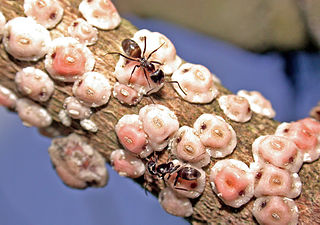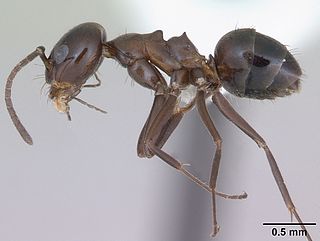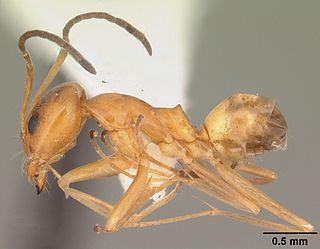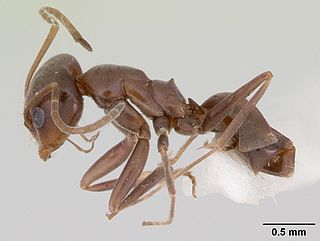
Dorymyrmex is a genus of ants in the subfamily Dolichoderinae.

Dorymyrmex insanus is a species of pyramid ant, one of several species known as crazy ants, for their "frenetic" movement and swarming behavior. It is found in hot, dry habitats in the southern parts of the United States, much of Central America, and tropical South America. Dorymyrmex insanus is listed as Vulnerable by the International Union for Conservation of Nature (IUCN).

Dorymyrmex bicolor is a species of ant in the Dolichoderinae subfamily, known by some as cone ants due to the shape of their mounds. Dorymyrmex bicolor was recently known as Conomyrma bicolor but has been renamed to Dorymyrmex bicolor. Dorymyrmex bicolor has a single petiole and a slit-like orifice which releases chemical compounds. This ant does not have the capability to sting. Dorymyrmex bicolor is primarily found in arid desert regions in Central and South America and the southwestern United States.
Dorymyrmex antarcticus is a species of ant in the genus Dorymyrmex. Described by Forel in 1904, the species is endemic to Argentina and Chile.

Dorymyrmex bituber is a species of ant in the genus Dorymyrmex. Described by Felix Santschi in 1916, the species is endemic to Argentina and Paraguay.

Dorymyrmex bureni, also known as the pyramid ant, is a species of ant in the genus Dorymyrmex. Described by Trager in 1988, the species is endemic to the United States and Mexico. Pyramid ants are medium-sized ants, ranging from 2–4 mm. They are light orange in color and fast moving. Unlike other ants in the area like red imported fire ants, this species is not aggressive towards humans. The workers have a foul smelling coconut odor when crushed. Dorymyrmex bureni hunt living insects, even other winged ants. They also search for sap-sucking insects from which they collect honeydew. On the head of these ants are curved hairs, used for transporting beads of damp sand. Colonies are small. Nests usually have a single entrance with a mound of sand shaped like a crater. Dorymyrmex bureni prefer sandy soil. This species of ant is not an indoor pest, and pesticides should not be used. They are found throughout Florida.
Dorymyrmex caretteoides is a species of ant in the genus Dorymyrmex. Described by Forel in 1914, the species is endemic to Argentina.
Dorymyrmex chilensis is a species of ant in the genus Dorymyrmex. Described by Forel in 1911, the species is endemic to Chile.
Dorymyrmex coniculus is a species of ant in the genus Dorymyrmex. Described by Felix Santschi in 1922, the species is endemic to Argentina.

Dorymyrmex elegans is a species of ant in the genus Dorymyrmex. Described by Trager in 1988, the species is endemic to the United States and Mexico, where it is a nocturnal species and is normally seen on cool days.
Dorymyrmex emmaericaellus is a species of ant in the genus Dorymyrmex. Described by Kusnezov in 1951, the species is endemic to Bolivia.

Dorymyrmex exsanguis is a species of ant in the genus Dorymyrmex. Described by Forel in 1912, the species is endemic to Argentina and Paraguay.

Dorymyrmex jheringi is a species of ant in the genus Dorymyrmex. Described by Forel in 1912, the species is endemic to Brazil and Paraguay.
Dorymyrmex minutus is a species of ant in the genus Dorymyrmex. Described by Emery in 1895, the species is endemic to Argentina and Chile
Dorymyrmex pappodes is a species of ant in the genus Dorymyrmex. Described by Snelling in 1975, the species is endemic to Chile.

Dorymyrmex smithi is a species of ant in the genus Dorymyrmex. Described by Cole in 1936, the species is endemic to the United States and Mexico.

Dorymyrmex spurius is a species of ant in the genus Dorymyrmex. Described by Felix Santschi in 1929, the species is endemic to Argentina, Brazil, Paraguay and Uruguay.

Dorymyrmex is a species of ant in the genus Dorymyrmex. Described by Gallardo in 1916, the species is endemic to Argentina, Paraguay and Venezuela.
Dorymyrmex tuberosus is a species of ant in the genus Dorymyrmex. Described by Cuezzo and Guerrero in 2011, the species is endemic to Colombia.
Dorymyrmex xerophylus is a species of ant in the genus Dorymyrmex. Described by Cuezzo and Guerrero in 2011, the species is endemic to Colombia.











